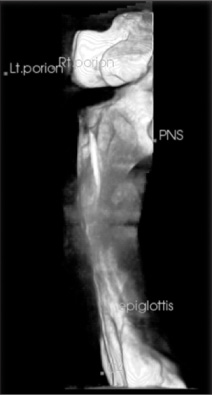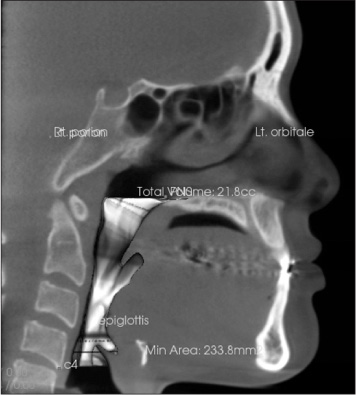J Korean Assoc Oral Maxillofac Surg.
2012 Feb;38(1):9-13. 10.5125/jkaoms.2012.38.1.9.
Three-dimensional analysis of pharyngeal airway change of skeletal class III patients in cone beam computed tomography after bimaxillary surgery
- Affiliations
-
- 1Department of Oral and Maxillofacial Surgery, Seoul St. Mary's Hospital, The Catholic University of Korea, Seoul, Korea. jupark@catholic.ac.kr
- KMID: 1434373
- DOI: http://doi.org/10.5125/jkaoms.2012.38.1.9
Abstract
- INTRODUCTION
To evaluate the 3-dimensional changes in the pharyngeal airway of skeletal class III patients after bimaxillary surgery.
MATERIALS AND METHODS
The study sample consisted of 18 Korean patients that had undergone maxillary setback or posterosuperior movement and mandibular bilateral sagittal split osteotomy setback surgery due to skeletal class III malocclusion (8 males, 10 females; mean age of 28.7). Cone beam computed tomography was taken 1 month before and 6 months after orthognathic surgery. Preoperative and postoperative volumes of the nasopharyngeal, oropharyngeal, and laryngopharyngeal airways and minimum axial areas of the oropharyngeal and laryngopharyngeal spaces were measured. Moreover, the pharyngeal airway volume of the patient group that had received genioplasty advancement was compared with the other group that had not.
RESULTS
The nasopharyngeal and laryngopharyngeal spaces did not show significant differences before or after surgery. However, the oropharyngeal space volume and total volume of pharyngeal airway decreased significantly (P<0.05). The minimum axial area of the oropharynx also decreased significantly.
CONCLUSION
The results indicate that bimaxillary surgery decreased the volume and the minimum axial area of the oropharyngeal space. Advanced genioplasty did not seem to have a significant effect on the volumes of the oropharyngeal and laryngopharyngeal spaces.
MeSH Terms
Figure
Reference
-
1. Pereira-Filho VA, Castro-Silva LM, de Moraes M, Gabrielli MF, Campos JA, Juergens P. Cephalometric evaluation of pharyngeal airway space changes in class III patients undergoing orthognathic surgery. J Oral Maxillofac Surg. 2011. 69:e409–e415.
Article2. Park JW, Kim NK, Kim JW, Kim MJ, Chang YI. Volumetric, planar, and linear analyses of pharyngeal airway change on computed tomography and cephalometry after mandibular setback surgery. Am J Orthod Dentofacial Orthop. 2010. 138:292–299.
Article3. Jakobsone G, Neimane L, Krumina G. Two- and three-dimensional evaluation of the upper airway after bimaxillary correction of Class III malocclusion. Oral Surg Oral Med Oral Pathol Oral Radiol Endod. 2010. 110:234–242.
Article4. Hong JS, Park YH, Kim YJ, Hong SM, Oh KM. Three-dimensional changes in pharyngeal airway in skeletal class III patients undergoing orthognathic surgery. J Oral Maxillofac Surg. 2011. 69:e401–e408.
Article5. Mattos CT, Vilani GN, Sant'Anna EF, Ruellas AC, Maia LC. Effects of orthognathic surgery on oropharyngeal airway: a metaanalysis. Int J Oral Maxillofac Surg. 2011. 40:1347–1356.
Article6. Chen F, Terada K, Hanada K, Saito I. Predicting the pharyngeal airway space after mandibular setback surgery. J Oral Maxillofac Surg. 2005. 63:1509–1514.
Article7. Kawakami M, Yamamoto K, Fujimoto M, Ohgi K, Inoue M, Kirita T. Changes in tongue and hyoid positions, and posterior airway space following mandibular setback surgery. J Craniomaxillofac Surg. 2005. 33:107–110.
Article8. Eggensperger N, Smolka W, Iizuka T. Long-term changes of hyoid bone position and pharyngeal airway size following mandibular setback by sagittal split ramus osteotomy. J Craniomaxillofac Surg. 2005. 33:111–117.
Article9. Saitoh K. Long-term changes in pharyngeal airway morphology after mandibular setback surgery. Am J Orthod Dentofacial Orthop. 2004. 125:556–561.
Article10. Marşan G, Cura N, Emekli U. Changes in pharyngeal (airway) morphology in Class III Turkish female patients after mandibular setback surgery. J Craniomaxillofac Surg. 2008. 36:341–345.
Article11. Muto T, Yamazaki A, Takeda S, Sato Y. Effect of bilateral sagittal split ramus osteotomy setback on the soft palate and pharyngeal airway space. Int J Oral Maxillofac Surg. 2008. 37:419–423.
Article12. Kawamata A, Fujishita M, Ariji Y, Ariji E. Three-dimensional computed tomographic evaluation of morphologic airway changes after mandibular setback osteotomy for prognathism. Oral Surg Oral Med Oral Pathol Oral Radiol Endod. 2000. 89:278–287.
Article13. Degerliyurt K, Ueki K, Hashiba Y, Marukawa K, Nakagawa K, Yamamoto E. A comparative CT evaluation of pharyngeal airway changes in class III patients receiving bimaxillary surgery or mandibular setback surgery. Oral Surg Oral Med Oral Pathol Oral Radiol Endod. 2008. 105:495–502.
Article14. Chen F, Terada K, Hua Y, Saito I. Effects of bimaxillary surgery and mandibular setback surgery on pharyngeal airway measurements in patients with Class III skeletal deformities. Am J Orthod Dentofacial Orthop. 2007. 131:372–377.
Article15. Marşan G, Vasfi Kuvat S, Oztaş E, Cura N, Süsal Z, Emekli U. Oropharyngeal airway changes following bimaxillary surgery in Class III female adults. J Craniomaxillofac Surg. 2009. 37:69–73.
Article16. Turvey TA, Hall DJ, Warren DW. Alterations in nasal airway resistance following superior repositioning of the maxilla. Am J Orthod. 1984. 85:109–114.
Article17. Ghoreishian M, Gheisari R. The effect of maxillary multidirectional movement on nasal respiration. J Oral Maxillofac Surg. 2009. 67:2283–2286.
Article18. Riley RW, Powell NB, Guilleminault C. Inferior sagittal osteotomy of the mandible with hyoid myotomy-suspension: a new procedure for obstructive sleep apnea. Otolaryngol Head Neck Surg. 1986. 94:589–593.
Article
- Full Text Links
- Actions
-
Cited
- CITED
-
- Close
- Share
- Similar articles
-
- Three dimensional cone-beam CT study of upper airway change after mandibular setback surgery for skeletal Class III malocclusion patients
- Postoperative changes in the pharyngeal airway space through computed tomography evaluation after mandibular setback surgery in skeletal class III patients: 1-year follow-up
- Pharyngeal airway analysis of different craniofacial morphology using cone-beam computed tomography (CBCT)
- Two-dimensional and volumetric airway changes after bimaxillary surgery for class III malocclusion
- Location and shape of the mandibular lingula: Comparison of skeletal class I and class III patients using panoramic radiography and cone-beam computed tomography





